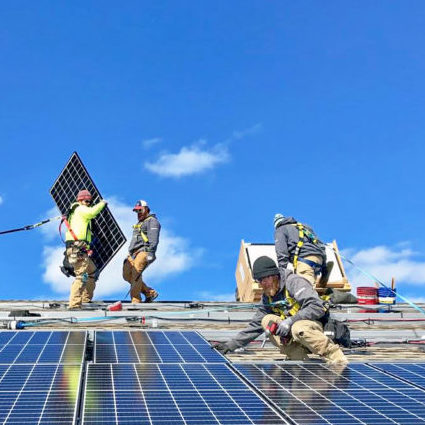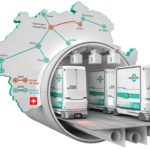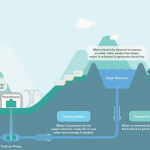Rational Cause for Optimism: Grid Modernization and Labor
Amidst the noise, haste, and chaos of modern life there are more positive developments for humanity than one might think. Everyone focuses on the disasters of the climate crisis, and while those do motivate our daily work, we also feel it’s important to highlight the hopeful – the very real innovations pushing our clean energy movement forward. The purpose of this new column on our blog is to explore noteworthy causes for optimism that we observe from ReVision Energy’s front row seat in the renewable energy arena.
Greatest Opportunity Since The New Deal
by Co-Founder Phil Coupe
Current events have drastically shifted global attitudes regarding the vulnerability of fossil fuel supply chains and the need for a rapid switch to renewable energy and clean technology. Russia’s petro-fueled atrocities in Ukraine and Putin’s threat to cut off natural gas supplies to western Europe have temporarily replaced the existential threat of climate damage as the number one motivation for nations to move away from coal, oil and gas.
“Beneficial Electrification” is the somewhat wonky industry term to describe the massive societal shift from burning fossil fuels to zero-emission electric appliances powered by renewables and energy storage. Using rooftop solar panels to charge an electric car is a good example of beneficial electrification; as are solar-powered heat pumps to heat and cool your home. Both solutions are cleaner, cheaper, and far more sustainable than combusting hydrocarbons.

We Need Hundreds of Thousands of Workers
America’s aging utility grid is crucial to beneficial electrification because demand for electricity to charge EVs and power heat pumps is scaling exponentially. Plus, the poles and wires transmit electricity from where it is available to where it is needed, say from a large rural solar farm to urban consumers, or from storage facilities to consumers. To enable a complete societal transition to clean energy, we need a utility grid with 4 to 6 times more capacity than today’s grid.
This urgently needed grid upgrade is a colossal infrastructure project, on par with the buildout of our interstate highway system in the 1950s and the massive public projects of the New Deal in the 1930s, both of which required hundreds of thousands of workers and spurred powerful economic progress nationwide.
Achieving beneficial electrification at the household scale is now commonplace, but people are waiting months for their clean energy installations across the U.S. due to a severe shortage of skilled labor. At this moment when clean energy demand is skyrocketing due to high energy costs and a war-mongering Russia, America doesn’t have the necessary human resources to kick beneficial electrification into overdrive.
A Multi-Pronged Approach
The multi-pronged solution to this labor problem includes education and recruiting, training and licensure, and making clean-tech jobs more attractive. That’s why ReVision Energy is continually delivering presentations to students at northern New England high schools, vocational schools, community colleges, and universities. It’s also why we are a Certified B Corp.
 Similar to Beneficial Electrification, “B Corp Certification” is another business term associated with creating a better future by ensuring companies do the right thing for employees, customers and the environment. One of the superpowers of a B Corp is being able to attract and retain talent because workers are beginning to understand they are likely to be treated better at a B Corp than they would at a more traditional company. If you know young people looking for a rewarding and remunerative career, please send them our way.
Similar to Beneficial Electrification, “B Corp Certification” is another business term associated with creating a better future by ensuring companies do the right thing for employees, customers and the environment. One of the superpowers of a B Corp is being able to attract and retain talent because workers are beginning to understand they are likely to be treated better at a B Corp than they would at a more traditional company. If you know young people looking for a rewarding and remunerative career, please send them our way.
During the Great Depression nearly a century ago, workers did not have the luxury of choosing what type of employer they wanted to work for. As the global economic system teetered on the brink of collapse, sowing unemployment, hunger and poverty throughout the world, workers were desperate for any kind of paying job.

Construction of the Hoover Dam in the 1930s
As a result, psychological depression plagued many in the 1930’s, just as it does today in the face of calamitous news about the war and climate damage. To save America and its citizens, President Franklin Delano Roosevelt launched a series of large-scale initiatives to resuscitate the economy and empower workers to earn a decent living. Among the many projects of this “New Deal” was the creation of the Tennessee Valley Authority (TVA) and the Hoover Dam, leading to vast quantities of cheap hydropower for the mid-Atlantic region and the southwest. Other infrastructure outcomes nationwide included the construction of 4,000 schools, 130 new hospitals, 9,000 miles of storm drains and sewer lines, 150 new airfields, 29,000 new bridges, 280,000 miles of roads, planting of 24 million trees and 700 new parks.
After more than 150 years of fossil fuel extraction, transport, refining, distributing and combustion, America is overdue for a national beneficial electrification plan that addresses our skilled labor and grid modernization crises. Transitioning society to a clean energy future is the greatest economic development and job creation opportunity since the New Deal.
Original Source: https://www.revisionenergy.com/blogs/beneficial-electrification/


















